

<< Go Back up to Region ‘Los Angeles: Downtown’
| Follow Mike Hume’s Historic Theatre Photography: |  |
 |
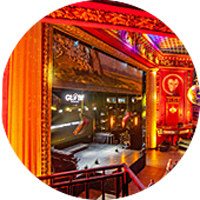
Architects: Morgan, Walls & Morgan (surrounding office building), Alfred F. Rosenheim (theatre interior)
First Opened: 6th January 1913 (111 years ago)
Former Names: Morosco Theater, President Theatre, Newsreel Theatre
Status: Closed; seeking new tenant
Website: www.globetheatre-la.com 
Telephone: (213) 489-1667 
Address: 740 South Broadway, Los Angeles, CA 90014 
The Globe Theatre was built in 1913 as the Morosco Theater, designed for full-scale legitimate dramatic productions at a time when most theatres were being built for vaudeville. The theatre was built as part of a larger office tower called the Garland Building, designed by Morgan, Walls & Morgan. The theatre interior was designed by Alfred F. Rosenheim.

 Detailed Information
Detailed Information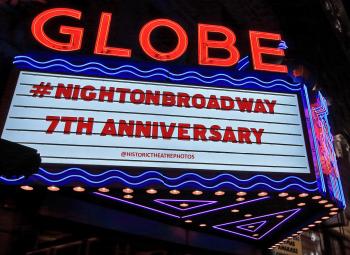
Oliver Morosco, a theatrical impresario, moved to Los Angeles in 1899, and at the start of 1913 opened the Morosco Theater on Broadway. Morosco already had interests in several Los Angeles theatres, chiefly the original Belasco Theatre on Main St (not to be confused with the current Belasco Theatre on Hill St), however he would concentrate his efforts on his eponymous theatre with faithful patrons from the Belasco being given priority booking for events at the new theatre.
Newspaper reports show that the opening was originally planned for 30th December 1912 however had to be pushed back by one week due to scenery being delayed for the opening production (it was being brought over from New York), and a delay in carpeting for the auditorium being delivered.
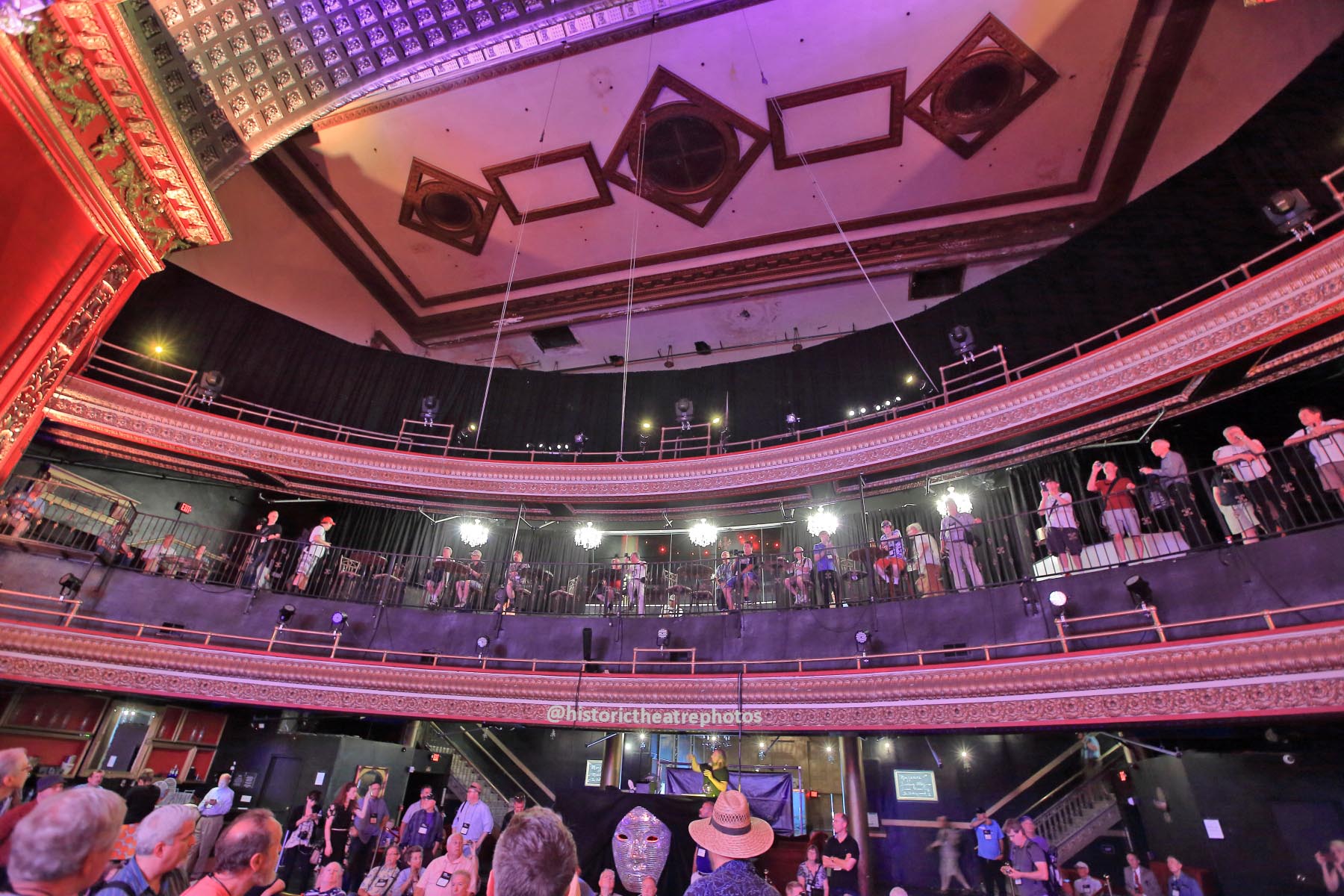
The auditorium has a Mezzanine and Balcony level, described at the time as being styled on the Broadway playhouses of New York. As was common for the time, the Balcony was not connected with the other levels of the auditorium. There is no evidence that it was racially segregated, rather in the more tolerant Los Angeles environment it was probably class segregation. Alleys on either side of the theatre building provided access to the Balcony and there was a separate ticket office for the Balcony in the north alley. The only other theatre on Broadway in Los Angeles which features two balconies is the Palace Theatre which opened as the Orpheum Theatre in 1911.
Theatre fires in recent memory of the Morosco being completed meant that an emphasis was placed on the safety of patrons visiting the theatre. The theatre was equipped with eight exits per side which led into wide alleys on either side of the theatre. The theatre was an all-concrete construction, practically the only flammable material being the stage scenery and wood contained in the auditorium seating.
The other aspect of the theatre touted in the newspapers of the time was the luxurious comfort of the theatre. There were only 17 rows of seats at Orchestra level, and the Mezzanine and Balcony both had just 12 rows. The generous seat pitch allowed patrons ample legroom. There were also special armchair-style seats in a few sections of the Orchestra, aimed at catering towards the more portly patrons!
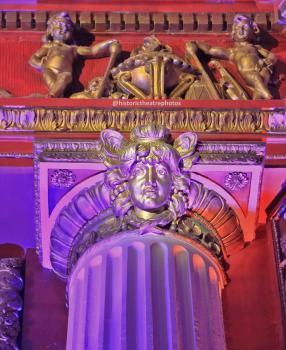
The color scheme was predominantly a French Grey with highlights in dull gold and green bronze. Panels were filled-in with light green and highlighted in old rose. It was felt the usual figures of mythical gods and muses were outdated, so the Morosco Theater got a dignified Classical design, of particular note the Rubenesque cupids in relief encircling the stage.
Following the example set by the European playhouses given over to the exclusive production of dramas, the Orchestra Pit was to have no orchestra. A “bank of Autumnal leaves” occupied the place where “not always musical music is dispensed by indifferent musicians”. In reality it was an Orchestra Pit mostly full of potted plants.
The theatre’s Fire [Safety] Curtain was painted by artist John Collette; it represented an English woodland scene in spring time. The Los Angeles Times was delighted with the curtain noting that it was “marvelous to relate [that] there are no figures in it nor cows”! John Collette went on to become the “master artist” at the theatre. In mid-November 1916 he was painting a 90-foot-wide cyclorama backdrop from the paint bridge at the rear of the stage at 3am when the backdrop collapsed and one of the straps suspending the cloth struck him on the head and rendered him unconscious, lying half off the paint bridge hanging 30ft above the stage floor and held safe by folds of the collapsed scenery until the morning crew arrived at the theatre and found him some hours later.
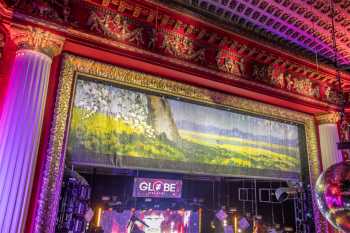
Morosco left the theatre in 1928 and the new management changed the name to the President Theatre, still showcasing legitimate drama. The effects of the Great Depression put an end to that scheme and in mid-1930 Fox West Coast Theatres took over the theatre, converted it for movies, and reopened it as Los Angeles’ first news theatre with a new name: Newsreel Theatre. The Balcony was closed at this time.
The theatre was the second all-newsreel theatre in the country, however the experiment did not prove commercially successful and in a little over a month the theatre reverted to being called the President Theatre and started showing movies.
Metropolitan Theatres took over management of the theatre in 1935, and by 1938 newsreels were back on and the theatre changed its name back to the Newsreel Theatre.
The existing marquee was added in the 1940s, however the original “Morosco” lettering can still be seen on the façade of the building behind the marquee.
In 1949 the theatre came under the management of Fox again, with Metropolitan pulling out and taking the Newsreel name to the Tower Theatre half a block down the street. The theatre’s name changed to the Globe Theatre, it’s assumed due the Globe atop the early 1940s marquee.
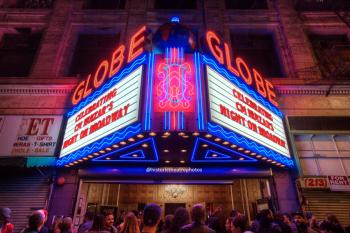
After its run as a newsreel theatre the Globe continued showing films as a third-run house and ended-up focusing on Spanish language films. In the late 1950’s a Mexican waxwork museum was added to complement the films being shown the theatre. The Barbershop setting currently on display at the Million Dollar Theatre is the sole survivor of this museum. The Globe played to dwindling audiences until its closure in mid-1986.
In 1987 the floor was leveled from the lobby to the stage and the theatre played host to a swap meet. After the swap meet proved unsuccessful, the Broadway entrance was walled-off from the auditorium and converted into retail, with the theatre turning into a nightclub called Club Orion, accessed from the alley behind the theatre.
In the early 2000’s the nightclub changed to Club 740 and featured a VIP room downstairs below the auditorium. Club 740 was ultimately shut down in 2011 following repeated noise issues and violence.

In 2014 new tenants took over management of the Globe and reopened it in 2015 using the Globe name as a live entertainment and music venue operating several nights per week. Retail units on the Broadway façade were removed and the original theatre entrance opened-up, which revealed the historic mirrored lobby leading from the street into the auditorium. The original marble staircases from Orchestra level to the Balcony were uncovered and restored to their original appearance and the auditorium was redecorated. The uppermost level (the Balcony) remains closed to the public however the Mezzanine and Auditorium Boxes provide excellent places to experience events taking place at the busy venue.
The Globe was originally a hemp house with counterweight lines for electrics battens. Whereas the original grid is still in place, only a couple of counterweight lines are still rigged, and no hemp lines are in place anymore. All flown pieces are dead-hung from the grid or rigged on electric motors.
The Globe is notable for being one of the few Los Angeles theatres to retain its paint bridge. This gallery at Fly Floor level along the rear stage wall would have originally been where scenic artists would paint backdrops hanging immediately downstage of the paint bridge.
The stage is roughly 34ft deep, the proscenium being 38ft wide and 34ft high. The theatre’s original fire curtain, painted with a classical scene in vibrant colors, is still in place although it has not been moved up or down in many years.
 Movie, TV & Music Video Appearances
Movie, TV & Music Video Appearances . The Globe appears as the Casino Theatre in Atlantic City.
. The Globe appears as the Casino Theatre in Atlantic City. . The Globe plays a burlesque theatre, both inside and out.
. The Globe plays a burlesque theatre, both inside and out.
 . Interiors and exterior, showcasing the 1940s-era neon marquee.
. Interiors and exterior, showcasing the 1940s-era neon marquee. Listed/Landmark Building Status
Listed/Landmark Building Status (12th September 1978)
(12th September 1978) How do I visit the Globe Theatre?
How do I visit the Globe Theatre?As of mid-2017 the Globe does not offer tours however they host a multitude of events which are available to book online at the theatre’s website  .
.
The theatre is an active participant in Councilmember Jose Huizar’s annual Night On Broadway event (usually the last Saturday in January) when the theatre is opened-up to the public for free and hosts a variety of live entertainment programming. Check out the Night On Broadway website  for more details.
for more details.
 Further Reading
Further Reading has lots of information on The Globe with photographs and playbills over the years in addition to detailed information on the theatre’s original manager, Oliver Morosco.
has lots of information on The Globe with photographs and playbills over the years in addition to detailed information on the theatre’s original manager, Oliver Morosco. about The Globe include additional history and photos.
about The Globe include additional history and photos. contains further information on The Globe and its wider context as part of the 1913 Garland Building.
contains further information on The Globe and its wider context as part of the 1913 Garland Building. contains further information plus calendar of events at the theatre.
contains further information plus calendar of events at the theatre. .
. of architectural firm omnigiving’s work undertaken at the Globe Theatre.
of architectural firm omnigiving’s work undertaken at the Globe Theatre. , by Suzanne Tarbell Cooper, Amy Ronnebeck Hall, and Marc Wanamaker, published by Arcadia Publishing. ISBN 9780738555799.
, by Suzanne Tarbell Cooper, Amy Ronnebeck Hall, and Marc Wanamaker, published by Arcadia Publishing. ISBN 9780738555799. Technical Information
Technical Information Photos of the Globe Theatre
Photos of the Globe TheatrePhotographs copyright © 2002-2024 Mike Hume / Historic Theatre Photos unless otherwise noted.
Text copyright © 2017-2024 Mike Hume / Historic Theatre Photos.
For photograph licensing and/or re-use contact me here  .
.
| Follow Mike Hume’s Historic Theatre Photography: |  |
 |